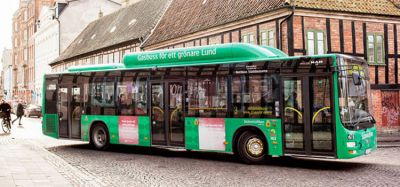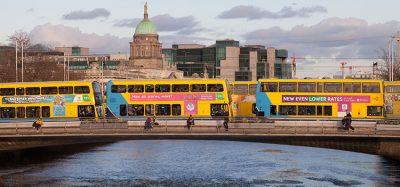The battle for BRT and public control in service integration
- Like
- Digg
- Del
- Tumblr
- VKontakte
- Buffer
- Love This
- Odnoklassniki
- Meneame
- Blogger
- Amazon
- Yahoo Mail
- Gmail
- AOL
- Newsvine
- HackerNews
- Evernote
- MySpace
- Mail.ru
- Viadeo
- Line
- Comments
- Yummly
- SMS
- Viber
- Telegram
- Subscribe
- Skype
- Facebook Messenger
- Kakao
- LiveJournal
- Yammer
- Edgar
- Fintel
- Mix
- Instapaper
- Copy Link
Posted: 12 December 2019 | Michael Kodransky - ITDP | No comments yet
Michael Kodransky, U.S. Director of the Institute for Transportation & Development Policy (ITDP), explains the challenges behind bus rapid transit (BRT) implementation and the need for a sterner public hand in data management and the integration of services.


Despite the obvious benefits of BRT adoption, why is it still such a challenge to get cities to implement it properly?
There are a number of efforts calling themselves BRT that are not – they’re just simple bus service improvements that are then being marketed as BRT, which is what advocates call BRT creep. There are a number of cities looking to implement BRT properly, but a great deal more embracing BRT creep and very basic improvements. This is one of the reasons ITDP developed a BRT Standard – to ensure there is a high level of excellence in a system’s design.
Some cities are proposing BRT along highway shoulders because there’s little to no resistance from road planners, as it doesn’t reduce capacity for other road users. This would involve building stations on highways and having customers board and alight on highways. That doesn’t make for the standard of passenger experience that BRT should provide. It’s critical that the systems are designed to take people to destinations they actually want to go to – only in this way can they provide genuine community value. It’s critical that services reach densely-populated areas, but it’s in these places that there are difficulties and numerous competing demands vying for finite road space. In the end, it is a political decision, but the benefits need to be communicated to the wider public. Without someone to make a case for it, prospective BRT systems will find it difficult to compete against other modes in those densely-populated areas. It will instead be implemented in places where there’s less resistance but where it will also be less effective in serving the public.
We’re reaching an inflection point in the perception of what bus services can do. Buses have traditionally been viewed as a social service for the poor, but that is gradually changing as more BRT corridors are emerging.
One example of this in the U.S. is Richmond, Virginia; there is often a decoupling between transport and land use, but they approached the two together, realising that for strong adoption of services and to justify the operational costs, you need high population density. Richmond revised its land usage code and parking regulation to ensure that public transport is more of a priority in order to nudge people towards using it, which isn’t easy in a society designed for car use.
Is there an image problem for buses that means BRT faces an uphill struggle regardless of the benefits it can bring to a community?
To convince the public that the service they would get is superior to anything else they currently have requires marketing messages that separate BRT from normal bus services. The BRT corridor in Bogota, for example, is called TransMilenio to remove association with buses.
The guide ITDP developed offers advice to authorities on how to engage communities along BRT corridors so that they understand what they will be getting, and also marketing the corridor so that the wider public understands what it is getting. Marketing is crucial because of pinchpoints that need to be negotiated and to help explain why decisions are being made, as they’re made. It’s all part of a political change management process – they’re not technical parts of BRT implementation, but they’re very much a part of the formula for how to design a BRT corridor.
Buses have traditionally been viewed as a social service for the poor, but that is gradually changing as more BRT corridors are emerging
In the U.S., we mostly only see individual corridors launching, so it will be interesting to see what happens in Indianapolis, which is planning multiple corridors to develop more of an overall system.
In this vein, Mexico City is probably the best example of a BRT system in the western hemisphere – it has seven BRT lines that are integrated with metro and bike-share. When you see a map of those services, you see a high-frequency, integrated transit network that happens to include bus services, rather than an out-and-out bus system.
With the urban transport sector trending toward integration, how important is it to join up services like this?
The industry tends to talk about digital integration at the moment, but full physical integration is crucial. There are high-frequency trunk lines that almost cross over, but almost isn’t quite enough anymore, so when people need to walk from one to the other, there is noticeable drop off in ridership. Physical integration provides ease of access that helps make life simpler for travellers. Digital integration, whilst very important, will not help solve those physical challenges.
Another important aspect is fare integration. Payment and ticketing methods that can be used across modes, like Oyster in London or Navigo in Paris, help remove another point of friction in peoples’ journeys. The more points of friction there are in trying to get from A to B, the less likely it is that people will use that service – even if it also brings numerous other benefits with it.
What kind of policies need to be developed to support the level of integration that the industry is currently aiming for, and how does that process begin?
The industry is not a monolith – it now has significantly more private players than has ever been seen, many of which are providing mobility options the likes of which have never been seen. The intention is not only to get people out of privately-owned cars, but also to extend the reach of mass transit trunk lines and high-frequency lines. As this trend continues, there is a very obvious tension about data ownership in terms of peoples’ movement.
Public agencies are best positioned to plan for the future. They understand the dynamic of their city and region better than anyone because they are structurally designed – when they work responsibly and transparently – to think long term about public interest rather than about short-term profit gain.
The industry tends to talk about digital integration at the moment, but full physical integration is crucial
The private sector might also be socially minded, but it is designed to increase its own profit. As we move towards having multiple mobility modes available on one digital platform, the data from those platforms is not available to the public sector. There needs to be an open source platform for the public sector to access. There is progress being made, for example in Los Angeles, where there is a protocol that has the intention of getting several private operators to use a single open source platform. It’s a real challenge to get the private sector to share its data for fear that it might eat into profits and open them up to new competition.
Determining who has access to the platform and how it is managed is the fundamental challenge that needs to be solved in order to enable better integration. The sector is moving into an era where the price of a transit service is individualised based on a company’s assessment of the customer’s willingness to pay. The public entities have no way of obtaining that kind of data and it is creating an inequality that the industry has never been challenged by before.
Public planning authorities can design standards and regulations that guide new types of mobility services using the public right-of-way to benefit more than just the privileged.
Biography
Michael Kodransky is the U.S. Director at the Institute for Transportation & Development Policy (ITDP), leading all ITDP programmatic activities in the United States. In the next decade, he wants to break down the virtuous cycle of car use ingrained in US society. Kodransky has worked to improve economic and social conditions for people in cities around the world, partnering with multiple levels of government in dozens of cities and countries, local and international NGOs, research centres, foundations, and development banks to accelerate the implementation of sustainable transport.
Related topics
Infrastructure & Urban Planning, Mobility Services, Public Transport, Transport Governance & Policy
Issue
Issue 4 2019
Related modes
Bus & Coach
Related cities
United States of America
Related organisations
Institute for Transportation & Development Policy (ITDP)








